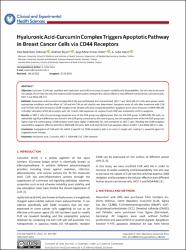Hyaluronic acid-curcumin complex triggers apoptotic pathway in breast cancer cells via CD44 receptors
Citation
Mokhberioskouei, Z., Biçim, G., Yilmaz, A., Yalçın, A. S. (2023). Hyaluronic Acid-Curcumin Complex Triggers Apoptotic Pathway in Breast Cancer Cells via CD44 Receptors. Clinical and Experimental Health Sciences, 13(3), 658-663.Abstract
Objective: Curcumin (CUR) was modified with hyaluronic acid (HA) to increase its water solubility and bioavailability. Our aim was to increase the uptake of CUR into the cells that express CD44 receptors and to compare the cellular effects in two different human breast carcinoma cells, MCF-7 and MDA-MB-231.
Methods: Hyaluronic acid-curcumin complex (HA-CUR) was synthesized and characterized.
MCF-7 and MDA-MB-231 cells were grown under appropriate conditions and the effect of CUR and HA-CUR on cell viability was determined. Apoptosis levels of cells after treatment with CUR and HA-CUR were also measured. CD44 receptor levels of both cells were compared and then apoptosis levels were measured in MDA-MB-231 cells after saturation of CD 44 receptors with HA. In both cells expression of caspase-9 and PARP was analyzed to confirm apoptosis.
Results: In MCF-7 cells, the percentage apoptosis level of the CUR group was slightly lower than the HA-CUR group. In MDA-MB-231 cells, no statistically significant difference was found in the CUR group compared to the control group, but the apoptosis level of the HA-CUR group was higher than the control group. CD44 receptor levels were higher in MDA-MB-231 cells compared to MCF-7 cells. Blocking the CD44 receptors reversed the apoptotic effect of HA-CUR in MDA-MB-231 cells. Both CUR and HA-CUR had apoptotic effects in MCF-7 and MDA-MB-231 cells.
Conclusion: Conjugation of CUR with HA, which is specific for CD44 receptors aids, in its entry to target cells making it a powerful agent for targeted cancer therapy.
Source
Clinical and Experimental Health SciencesVolume
13Issue
3URI
https://dergipark.org.tr/en/pub/clinexphealthsci/issue/79797/1185564https://doi.org/10.33808/clinexphealthsci.1185564
https://hdl.handle.net/20.500.12780/855


















